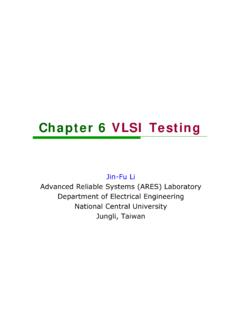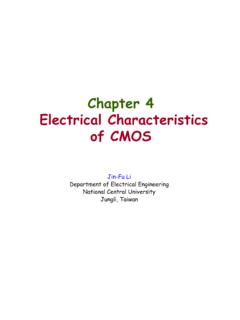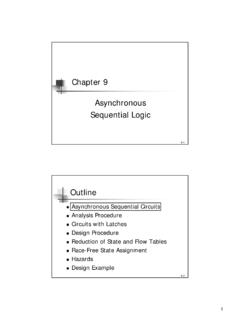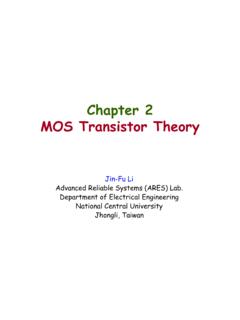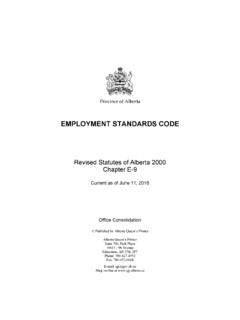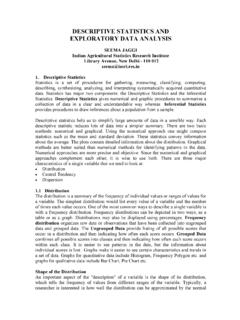Transcription of Chapter 2 Basic Structure of Computers - NCU
1 Jin-Fu LiDepartment of Electrical EngineeringNational Central UniversityJungli, TaiwanChapter 2 Chapter 2 basic structure of computers Basic Structure of Computers Advanced Reliable Systems (ARES) Lab. Jin-Fu Li, EE, NCU2 Functional Units Basic Operational Concepts Bus Structures Software PerformanceOutlineAdvanced Reliable Systems (ARES) Lab. Jin-Fu Li, EE, NCU3 Content Coverage Main Memory SystemInput/Output SystemArithmetic andLogic UnitOperational RegistersProgram CounterControl UnitData/InstructionAddressCentral Processing Unit (CPU)CachememoryInstruction SetsAdvanced Reliable Systems (ARES) Lab.
2 Jin-Fu Li, EE, NCU4 A computer consists of three main parts: A processor (CPU) A main-memory system An I/O system The CPU consists of a control unit, registers, the arithmetic and logic unit, the instruction execution unit, and the interconnections among these components The information handled by a computer Instruction Govern the transfer information within a computer as well as between the computer and its I/O devices Specify the arithmetic and logic operations to be performed Data Numbers and encoded characters that are used as operands by the instructionsFunctional UnitsAdvanced Reliable Systems (ARES) Lab.
3 Jin-Fu Li, EE, NCU5 A list of instructions that performs a task is called a program The program usually is stored in a memory called program memory The computer is completely controlled by the stored program, except for possible external interruption by an operator or by I/O devices connected to the machine Information handled by a computer must be encoded in a suitable format. Most present-day hardware employs digital circuits that have only two stable states, 0 (OFF) and 1 (ON)ProgramAdvanced Reliable Systems (ARES) Lab.
4 Jin-Fu Li, EE, NCU6 Memory The storage area in which programs are kept when they are running and that contains the data needed by the running programs Types of memory Volatile memory: storage that retains data only if it is receiving power, such as dynamic random access memory (DRAM) Nonvolatile memory: a form of memory that retains data even in the absence of a power source and that is used to store programsbetween runs, such as flash memory Usually, a computer has two classes of storage Primary memory and secondary memory Primary memory Also called main memory.
5 Volatile memory used to hold programs while they are running; typically consists of DRAM in today s Computers Memory UnitAdvanced Reliable Systems (ARES) Lab. Jin-Fu Li, EE, NCU7 Secondary memory Nonvolatile memory used to store programs and data between runs; typically consists of magnetic disks in today s Computers The memory consists of storage cells, each capable of storing one bit of information The storage cells are processed in groups of fixed size called words To provide easy access to any word in the memory.
6 A distinct address is associated with each word location The number of bits in each word is often referred to as the word length of the computer Typical word length from 16 to 64 bits The capacity of the memory is one factor that characterizes the size of a computerMemory UnitAdvanced Reliable Systems (ARES) Lab. Jin-Fu Li, EE, NCU8 Instruction and data can be written into the memory or read out under the control of the processor It is essential to be able to access any word location in the memory as quickly as possible Memory in which any location can be reached in a short and fixed amount of time after specifying its address called random-access memory (RAM)
7 The time required to access one word is called the memory access time This time is fixed, independent of the location of the word being accessed The memory of a computer is normally implemented as a memory hierarchy of three or four levels The small, fast, RAM units are called caches The largest and slowest unit is referred to as the main memoryMemory UnitAdvanced Reliable Systems (ARES) Lab. Jin-Fu Li, EE, NCU9 Most computer operations are performed in the arithmetic and logic unit (ALU) of the processor For example, consider two numbers stored in the memory are to be added They are brought into the processor, and the actual addition is carried out by the ALU.
8 Then sum may be stored in the memory or retained in the processor for immediate use Typical arithmetic and logic operation Addition, subtraction, multiplication, division, comparison, complement, etc. When operands are brought into the processor, they are stored in high-speed storage elements called registers. Each register can store one word of dataArithmetic and Logic UnitAdvanced Reliable Systems (ARES) Lab. Jin-Fu Li, EE, NCU10 The control unit is the nerve center that sends control signals to other units and senses their states Thus the control unit serves as a coordinator of the memory, arithmetic and logic, and input/output units The operation of a computer can be summarized as follows.
9 The computer accepts information in the form of programs and data through an input unit and stores it in the memory Information stored in the memory is fetched, under program control, into an ALU, where it is processed Processed information leaves the computer through an output unit All activities inside the machine are directed by the control unitControl UnitAdvanced Reliable Systems (ARES) Lab. Jin-Fu Li, EE, NCU11 computer Components: Top-Level general purpose registersProcessorInput/OutputSystem BusAdvanced Reliable Systems (ARES) Lab.
10 Jin-Fu Li, EE, NCU12 Basic Operational Concepts general purpose registersProcessorInput/OutputSystem BusR1 ALUR0 IRMARPCMDRA dvanced Reliable Systems (ARES) Lab. Jin-Fu Li, EE, NCU13A Partial Program Execution Example 0 0 0 0 0 22 9 4 15 9 4 11 9 4 09409413023013003001 9 4 0 PCACIRM emoryCPU RegisterStep 10 0 0 0 0 22 9 4 15 9 4 11 9 4 09409413023013003011 9 4 0 PCACIRM emoryCPU RegisterStep 20 0 0 30 0 0 0 0 22 9 4 15 9 4 11 9 4 09409413023013003015 9 4 1 PCACIRM emoryCPU RegisterStep 30 0 0 30 0 0 0 0 22 9 4 15 9 4 11 9 4 09409413023013003025 9 4 1 PCACIRM emoryCPU RegisterStep 40 0 0 33+2=50 0 0 5 Advanced Reliable Systems (ARES) Lab.
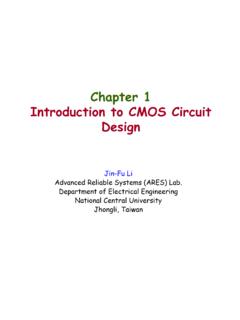
![Training Course of Design Compiler [相容模式]](/cache/preview/c/f/6/f/4/1/7/2/thumb-cf6f4172c80a30be0667109e5a50ce98.jpg)
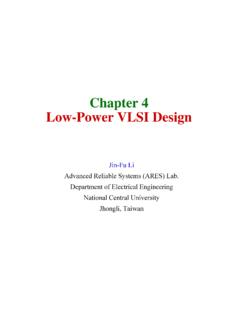
![hspice tutorial.ppt [相容模式] - ee.ncu.edu.tw](/cache/preview/0/1/e/d/5/5/6/4/thumb-01ed55640fe3958cfb144af3846e1fcf.jpg)
